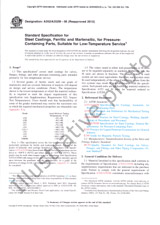We need your consent to use the individual data so that you can see information about your interests, among other things. Click "OK" to give your consent.
ASTM B580-79(2019)
Standard Specification for Anodic Oxide Coatings on Aluminum
Translate name
STANDARD published on 1.4.2019
The information about the standard:
Designation standards: ASTM B580-79(2019)
Note: WITHDRAWN
Publication date standards: 1.4.2019
SKU: NS-945898
The number of pages: 3
Approximate weight : 9 g (0.02 lbs)
Country: American technical standard
Category: Technical standards ASTM
The category - similar standards:
Annotation of standard text ASTM B580-79(2019) :
Keywords:
ICS Number Code 25.220.20 (Surface treatment)
Additional information
| 1. Scope | ||||||||||||||||||||||||||||||
|
1.1 This specification covers requirements for electrolytically formed porous oxide coatings on aluminum and aluminum alloy parts in which appearance, abrasion resistance, electrical properties, and protection against corrosion are important. Nonporous, barrier layer anodic coatings used for electrical capacitors are not covered. Seven types of coatings as shown in Table 1 are provided. Definitions and typical examples of service conditions are provided in Appendix X1. Note 1: It is recognized that uses exist in which
modifications of the coatings covered by this specification may be
required. In such cases the particular properties desired by the
purchaser should be the subject of agreement between the purchaser
and the manufacturer.
1.2 The values stated in SI units are to be regarded as standard. No other units of measurement are included in this standard. 1.3 This international standard was developed in accordance with internationally recognized principles on standardization established in the Decision on Principles for the Development of International Standards, Guides and Recommendations issued by the World Trade Organization Technical Barriers to Trade (TBT) Committee. |
||||||||||||||||||||||||||||||
| 2. Referenced Documents | ||||||||||||||||||||||||||||||
|



 Cookies
Cookies
